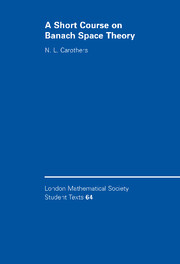Book contents
- Frontmatter
- Contents
- Preface
- 1 Classical Banach Spaces
- 2 Preliminaries
- 3 Bases in Banach Spaces
- 4 Bases in Banach Spaces II
- 5 Bases in Banach Spaces III
- 6 Special Properties of c0, l1, and l∞
- 7 Bases and Duality
- 8 Lp Spaces
- 9 Lp Spaces II
- 10 Lp Spaces III
- 11 Convexity
- 12 C(K) Spaces
- 13 Weak Compactness in L1
- 14 The Dunford–Pettis Property
- 15 C(K) Spaces II
- 16 C(K) Spaces III
- Appendix Topology Review
- References
- Index
10 - Lp Spaces III
Published online by Cambridge University Press: 06 January 2010
- Frontmatter
- Contents
- Preface
- 1 Classical Banach Spaces
- 2 Preliminaries
- 3 Bases in Banach Spaces
- 4 Bases in Banach Spaces II
- 5 Bases in Banach Spaces III
- 6 Special Properties of c0, l1, and l∞
- 7 Bases and Duality
- 8 Lp Spaces
- 9 Lp Spaces II
- 10 Lp Spaces III
- 11 Convexity
- 12 C(K) Spaces
- 13 Weak Compactness in L1
- 14 The Dunford–Pettis Property
- 15 C(K) Spaces II
- 16 C(K) Spaces III
- Appendix Topology Review
- References
- Index
Summary
As pointed out earlier, the spaces Lp and lp exhaust the “isomorphic types” of Lp(μ) spaces. Thus, to better understand the isomorphic structure of Lp(μ) spaces, we might ask, as Banach did:
For p ≠ r, can lr or Lr be isomorphically embedded into Lp?
We knowquite a bit about this problem.We knowthat the answer is always yes for r = 2, and, in case 2 < p < ∞, the Kadec–Pelczyński theorem (Corollary 9.7) tells us that r = 2 is the only possibility. In this chapter we'll prove the following statement:
If p and r live on opposite sides of 2, there can be no isomorphism from Lr or lr into Lp.
This leaves open only the cases 1 = r < p < 2 and 1 ≤ p < r < 2. The first case can also be eliminated, as we'll see, but not the second.
Unconditional Convergence
We next introduce the notion of unconditional convergence of series. What follows are several plausible definitions.
We say that a series Σn xn in a Banach space X is
(a) unordered convergent if Σn xπ(n) converges for every permutation (one–to–one, onto map) π : ℕ → ℕ;
(b) subseries convergent if Σk xnk converges for every subsequence (xnk) of (xn);
(c) “random signs” convergent if Σn εn xn converges for any choice of signs εn = ±1;
(d) bounded multiplier convergent if Σn an xn converges whenever |an| ≤ 1.
Information
- Type
- Chapter
- Information
- A Short Course on Banach Space Theory , pp. 99 - 106Publisher: Cambridge University PressPrint publication year: 2004
